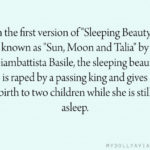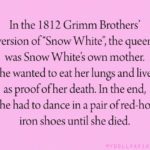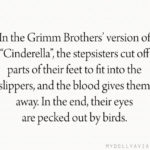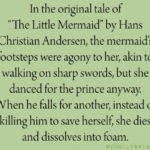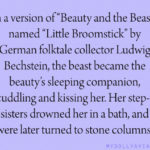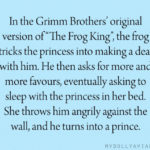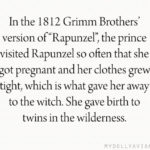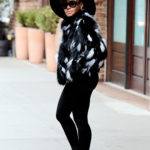the reason oppressed groups say “___ are awful” instead of “some ___ are awful” is because including the word “some” allows individuals of that group to detach themselves from the problem and shuck the blame off and say “well they arent really talking about me so i can ignore their opinions”, whereas stating that an entire group of oppressors is awful makes the individual think whether or not theyre included in the awfulness of that group and makes them consider their actions so thats why people say “men are awful” or “white people are awful” and if you take it personally you’re getting angry at the wrong people
#if you take it personally you’re probably part of the problem
Month: April 2015
Disney vs. 7 early fairytales
The 1812 version of Snow White is even worse when you consider that the girl was only seven years old in the tale (plus her unconscious body ended up being carted around by the prince until one of his servants accidentally woke her up). Also, in The Little Mermaid, the mermaid’s unable to speak because she had her tongue cut out >__<
But I’d love to see faithful adaptations of the original tales. Especially Bluebeard. We need a Bluebeard adaptation.
Actually, the original-original pre-Grimm Brothers’ stories that were passed around Europe via oral tradition are nowhere near as violent as the Grimm’s made them. Cinderella’s stepsisters were never ugly and kept their eyes, Snow White’s mother was not even a villain (instead a group of bandits were), and instead of spending the whole story napping Sleeping Beauty outwitted a dangerous bandit leader, wouldn’t let him sleep with her, and saved herself.
The original oral stories were radically changed by the Brothers Grimm to fit their personal and political beliefs. Most notably, they often added in female characters solely for the purpose of making them evil villains and took away most of the heroines’ agency and intelligence. Both brothers belonged to a small fanatical sect of Catholicism that vilified women because of the idea of Original Sin and Wilhelm in particular had a particularly deep hatred of women. The Grimms were actually pretty horrible people. Those cannibalistic queens and ugly stepsisters and the mass amount of violence against women didn’t exist until the Grimms wanted them to. Their ideas stuck so soundly though that we now assume they were in the original tales and that these terrible characters and ideas come out of some perceived barbaric Old World culture. But in truth they’re really the Grimms’ weird obsession with hating women showing through. The original oral folklore focused on the heroes’ and heroines’ good deeds and used them as ways to teach cultural norms and a society’s rules and encouraged girls to be quick-witted and street-savvy instead of passive princesses, and the Grimms promptly stripped that all away.
“Grimms Bad Girls and Bold Boys” by Ruth Bottingheimer is an excellent book on this
We had to read The Book of Lost Things for school and it’s Grimm level crazy
Not only that, you’re skipping out a really important thing: the brother’s grimm got those tales from WOMEN, women were the ones who would tell these tales orally and the brother’s grimm took them, altered them to be sexist and never gave the women credit. You can read Clever Maids the Secret History The Grimm Fairytales for more info
reblogging for the excellent commentary
oh I never knew this holy shit
Relationships that I want to see more of in fiction
StandardNon-romantic sexual partnerships that are portrayed as healthy, meaningful and committed.
Romantic non-sexual partnerships in which the lack of sex isn’t a cause of angst or tension.
Platonic, non-sexual partnerships that are put on the same level as committed romantic partnerships.
Short-term relationships that are treated as happy and meaningful, and for which the end is considered a natural progression instead of a tragedy.
Polyamorous families and group marriages.
Love triangles that are resolved by polyamory instead of by competition and jealousy.
Healthy BDSM relationships in which communication, mutual respect and clear boundaries are shown to be just as important as the kinky stuff.
Non-BDSM relationships making use of safewords and other kinds of consent practices to manage intimacy.
Relationships in which the people explicitly talk about what kinds of touch they’re comfortable with and what they dislike.
Relationships that don’t involve any kind of physical contact, but are based on other kinds of intimacy and affection instead.
“Shallow” relationships that don’t involve commitment or intense closeness being treated as different, but equally valid and not inferior, compared to “deeper” relationships.
Stories in which a character’s relationship with themself is treated as more important than their connection to another person.
Relationships break-ups that are treated as good decisions instead of as miserable and melodramatic.
Relationships in which controlling, manipulative or abusive behavior is recognized for what it is instead of being romanticized, and the other characters shut that shit down.
Characters who get out of abusive relationships and rebuild their lives.
Married people who still act sweet, appreciative and funny to each other after being together for years, instead of taking each other for granted or fighting all the time.
Romance stories that explore what happens after people get married instead of ending as soon as the characters have sex/get together/get married.
Stories in which the hero rescues the damsel in distress, but they don’t become a couple, because the damsel already has a girlfriend, and the hero knows that saving a woman does not mean he’s entitled to have her.
Long-running close friendships between men and women, with no hint of sexual/romantic interest, ever.
Female+female platonic relationships that are treated as special and important in the same way “bromances” are.
Relationships between people of the same gender that all the characters treat as normal, and the plot doesn’t revolve around coming out or dealing with homophobia, and doesn’t end with one or both partners dying.
Relationships with trans and/or non-binary characters whose gender is acknowledged but isn’t treated as weird or as a source of drama.
Relationships with disabled characters who aren’t treated as “tragic,” “pitiable,” or “inspirational” because of their disabilities.
Different types of attraction: sexual, sensual, romantic, platonic, aesthetic.
Existential attraction: when you’re just really glad someone exists out there in the world and whether you get to try out the other attractions or not you hope they have good things forever.
Every time you eat at McDonalds as a kid it’s a victory. Every time you eat at McDonalds as an adult it’s a defeat.
I begin to long for some little language such as lovers use, broken words, inarticulate words, like the shuffling of feet on pavement.
dykewithadick replied to your post: okay I think I figured it outI don’t m…
Where is restaurant hopping a thing and how much does it cost to get to there?
Restaurant hopping is wherever I am
I *loooooove* restaurant hopping. YASSS. Yes.
